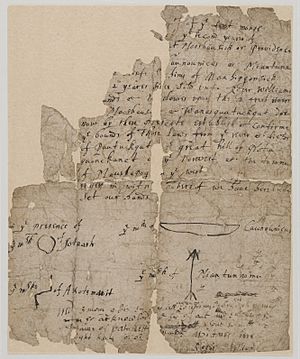Canonicus facts for kids
Quick facts for kids
Canonicus
|
|
|---|---|
 |
|
| Chief of the Narragansett | |
| Succeeded by | Miantonomoh |
| Personal details | |
| Born | c. 1565 |
| Died | June 4, 1647 |
| Relations | Miantonomoh (nephew) |
Canonicus (born around 1565 – died June 4, 1647) was a strong and respected leader of the Narragansett Indigenous Peoples. He was careful about the European settlers who arrived. However, he eventually became friends with Roger Williams and other colonists.
Contents
Canonicus: A Powerful Native American Leader
Canonicus was born around 1565. We don't know much about his early life. He became the chief of the Narragansett tribe. This was around the time the Pilgrims landed at Plymouth. He was one of the first Native American leaders to deal with them.
Early Encounters with European Settlers
Canonicus was worried when the white settlers first arrived. He saw them as a possible threat. In 1622, he challenged the Plymouth colony. He led about 5,000 Narragansett warriors. He sent a bundle of arrows wrapped in a snake skin to the Plymouth governor, William Bradford. This was a sign of challenge.
Governor Bradford responded in a clever way. He filled the snake skin with gunpowder and lead. Then he sent it back to Canonicus. This was the Narragansett's first time seeing such powerful items. It made a big impression on them.
Historians say this act caused "superstitious awe." The items were passed from village to village. They caused a lot of alarm among the Narragansett. Because of this, Canonicus decided to seek peace. He made a friendship treaty with the colonists. He kept this treaty, even when things were difficult. This peace lasted even after Canonicus died in 1647.
Friendship with Roger Williams
Later, Roger Williams was forced to leave Massachusetts Bay Colony. He found safety with the Narragansett tribe. Canonicus welcomed him warmly. In 1636, Canonicus gave Williams a large piece of land. On this land, Williams started Providence Plantations. This area later grew into the Colony of Rhode Island and Providence Plantations.
In 1637, Canonicus played a big role. He helped the Narragansetts decide to join the colonists. This was during the Pequot War. Their alliance was important for the colonists.
Leadership and Legacy
Canonicus's nephew, Miantonomoh, first took over as chief. But Miantonomoh was killed in 1643. So, Canonicus became the leader again. On April 19, 1644, he signed a formal treaty. In this treaty, he recognized the power of King Charles.
Canonicus's wisdom and advice were remembered for many years. The Narragansett tribe stayed peaceful with the colonists. This peace lasted until King Philip's War in 1675. Canonicus's nephew, Pessicus, even changed his name to Canonicus. He did this to honor his famous uncle. Canonicus's son, Mixan, died in 1657. Mixan's wife, Quaiapen, was the last Narragansett leader killed in King Philip's War.
Notable Descendants
- Jim Thorpe (1887-1953): He was an Olympic champion. Many called him the "world's greatest athlete."
Canonicus's Lasting Impact
- He was honored in 1997. He was inducted into the Rhode Island Heritage Hall of Fame.
- Four ships in the United States Navy were named USS Canonicus.
- There is a road named after Canonicus in Newport, Rhode Island.
- Another street is named after him in Tiverton, Rhode Island.
- The name of Conanicut Island comes from him.
- An actor named Michael Greyeyes played him. This was in the TV miniseries Saints & Strangers.
See also


